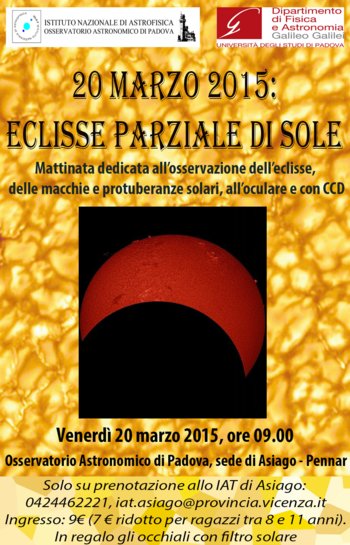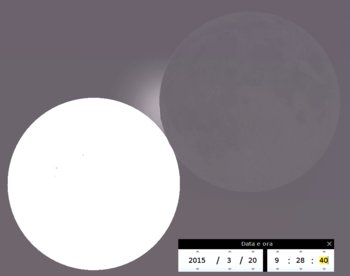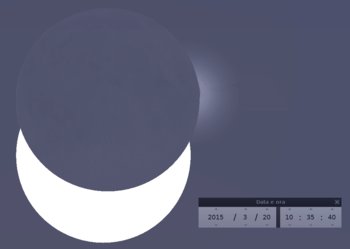Friday 20/3/2015 at 09:00
Astronomical Events
 The next March 20 in Italy there will be the next solar eclipse, an event eagerly awaited as to assist the next time you need to wait until 2026.
The next March 20 in Italy there will be the next solar eclipse, an event eagerly awaited as to assist the next time you need to wait until 2026.
For this important occasion, theAstronomical Observatory of Asiago in Pennar, Friday 20 March at 9.00, will, upon reservation, to attend this partial eclipse of the Sun. The morning is dedicated to the observation of the Eclipse, the solar spots and bumps to the eyepiece and CCD.
Admission: $ 9.00 total - € 7.00 concessions (children 8-11 years). Information and reservations at the IAT in Piazza Carli or by pressing the button below.
For those who cannot be present at the Asiago Observatory, the Eclipse will be visible in Italy between 9.30 and 11.30 about, with a peak at around 10.30. Using map, provided by NASA, you can verify the correct time for your location.
AtAsiago Observatory, the Moon lambirà the disk of the Sun at 9.27. the Eclipse will reach its maximum at about 10.35 phase and ends at 11.47.
From Asiago we will observe the Sun sickle-shaped and appreciably attenuated ambient light. If the sky is particularly clear, Venus will be visible to the naked eye (with the telescope will be able to view it easily).

HOW TO WATCH THE ECLIPSE
If you don't have the opportunity to watch the Eclipse of the Sun by the Centre but you do it from the place where you are, it's good to know that to observe anEclipse of the Sun you have to be sure to use the correct filter.
Although a filter seems to obscure almost all visible light of the Sun, this does not mean that blocks all ultraviolet and infrared radiation, which can be harmful to the eye even if the exposure is very short. An appropriate filter lets only 0.003% of the visible sunlight and 0.5% of the infrared radiation.: all others are not recommended.
THE GOGGLES
The goggles with protection index number 14 are the most common filter
naked-eye observation of the Sun, because they restrain effectively all the harmful radiation of the Sun.
MYLAR FILTERS
The Mylar filters, which are also very common, consist of two thin plastic sheets separated by a block of aluminum. Content filtering in aluminum prevents harmful rays to penetrate into the eye. Are often proposed in the form of "Eclipse glasses", namely cardboard glasses, whose "lenses" are composed of Mylarfilters.
Protective filters are cheaper to look at the Sun with the naked eye. Even those who
using a telescope, a pair of binoculars or a telescope can use Eclipse glasses, just place them in front of, on the side of the lens.
The Mylar filters you can buy in shops specialized in optical astronomy and are also available in the form of sheets, which can be clipped into the desired form. Those who want to build their own filter must be careful not to puncture or scratch the filter when the crop: a hole could let enough radiation to damage the eye. Also, make sure that the filter is not detached from the optical device to which it is attached.

THE GELATIN AND GLASS FILTERS
There are also glass filters or gelatin that can look at the Sun without any risk. They resemble the Mylarfilters, but they are of better quality and give a sharper image of the Sun, without the typical blue coloration of the first. Gelatin filters can be found in the form of Eclipse glasses; Although they are more expensive than in Mylar, are to be preferred because of better quality. They use the same precautions recommended for Mylar filters, both for use in the form of glasses for use with optical instruments.
LITTLE EFFECTIVE PROTECTION
Little effective Protection can seriously harm the eye: avoid sunglasses (even one above the other), photographic negatives overexposed, CD and floppy disc inside, smoked glass, solar filters for small telescopes.
All rights reserved.